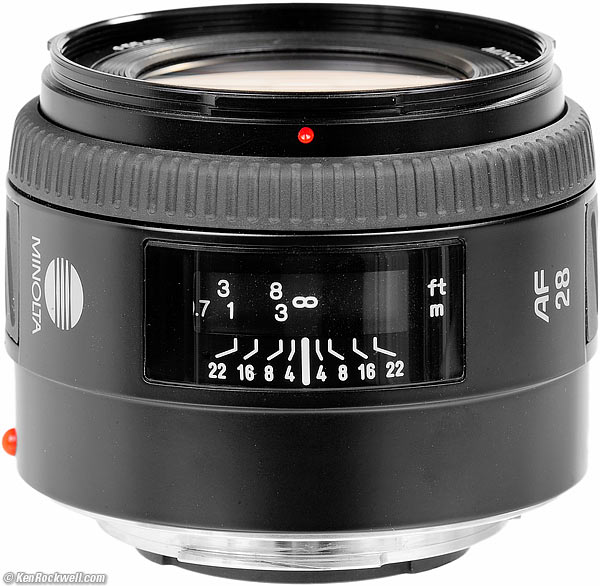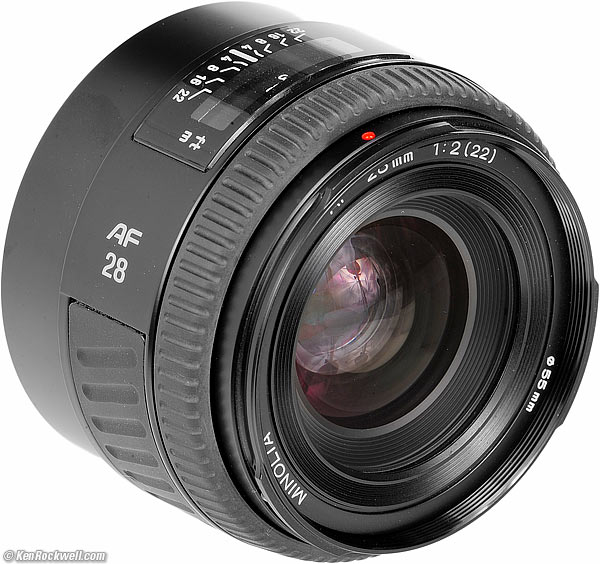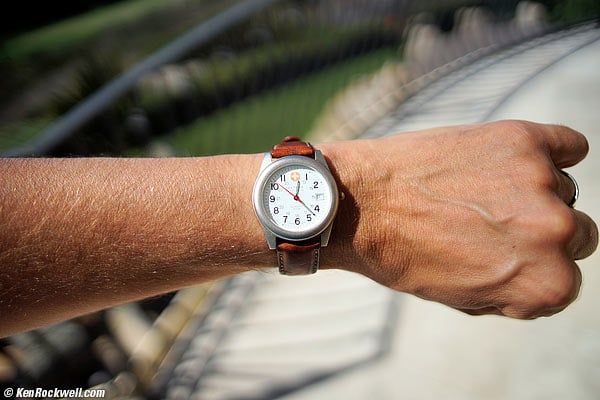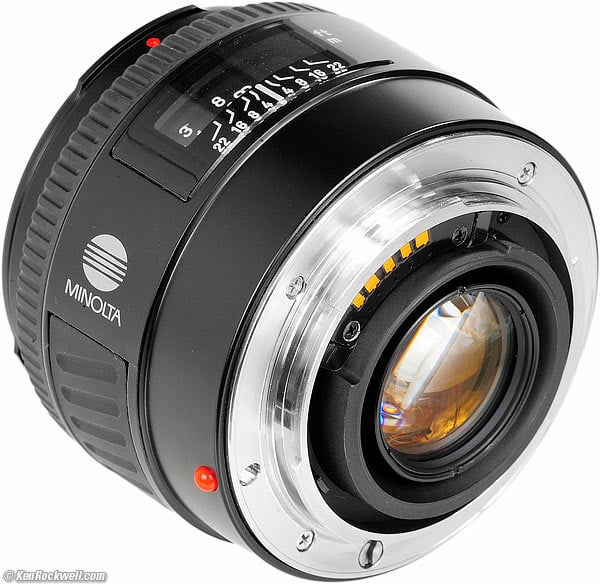Home Donate New Search Gallery Reviews How-To Books Links Workshops About Contact
Minolta 28mm f/2
Full-frame MAXXUM AF (1986-2006)
For Minolta and Sony Alpha
© 2013 KenRockwell.com. All rights reserved.
Intro Specifications Performance Recommendations
Minolta Maxxum 28mm f/2 (newer of two cosmetic versions shown here, metal 55mm filter thread, 1'/0.3m close focus, 9.9 oz./280g, about $500 used if you know How to Win at eBay). enlarge. My biggest source of support is when you use this link directly to them at eBay, or use any of these links when you get anything, regardless of the country in which you live. Please always use these links when getting any of your gear so I can continue to share what I know for free — but I receive nothing for my efforts if you buy elsewhere. Thank you for your support! Ken.
October 2013 Minolta Minolta Lenses Sony Pentax Nikon Canon more
Why fixed lenses take better pictures.
Introduction top
Intro Specifications Performance Recommendations
This Minolta Maxxum AF 28mm f/2 is an extremely well made and high-performance fast wide lens for all Sony Alpha and Minolta MAXXUM cameras.
Used on today's Sony A99 it has image stabilization and very fast autofocus.
This Minolta 28mm f/2 works perfectly on today's Sony A99, except that the AF-D Depth Map AF (whatever that is) and the automatic lens corrections don't work. So what, the images look fantastic and everything else works, like face recognition and all the focus modes including Direct Manual Focus (DMF) override, so all is well.
It's a marvel of precision, far better made than the plastic garbage Sony sells today. This lens has a super-smooth and precise focus helicoid and a metal filter thread and hood mount.
In fact, it's all metal except for the plastic outer barrel of this sample of the newer cosmetic version. The original 1986 version may have had an alloy outer barrel for all I know.
This is a full-frame lens for 35mm film and full-frame digital, and will be reviewed thusly. Feel free to use this on cropped-frame cameras, too, on which it will give even closer-cropped results.
History
1986-1999
The original version, not shown here, has a hard ribbed manual focus ring.
"AF" is marked in red on the front barrel.
Feet are marked in yellow on the focus scale.
1999-2006
Minolta changed the focus ring to rubber and cheapened the distance scale to show both feet and meters in white, not yellow for feet and white for meters as it should be.
Minolta also saved themselves another paint step by painting the "AF" on the front identity ring in the same color, white, as the rest of the letters. The first version painted the AF in red. The version here also removes the infra-red focus index entirely.
It has exactly the same optics as the 1986 version.
Casual amateurs give this a street name of "RS," or "restyled."
Another downgrade is that is newer 1999 version curved the seven diaphragm blades, which has no effect on bokeh, but makes the sunstars mostly go away.
2006-today
Sony bought Minolta and stopped selling this lens.
Minolta 28mm f/2. enlarge.
Specifications top
Intro Specifications Performance Recommendations
Name top
Minolta calls this the MAXXUM AF 28mm f/2 (22).
MAXXUM is Minolta's autofocus brand, also called Dynax outside the US.
The (22) is the smallest f/stop.
Optics top
9 elements in 9 groups.
Unit focus.
Multicoated, but not particularly well.
Diaphragm top
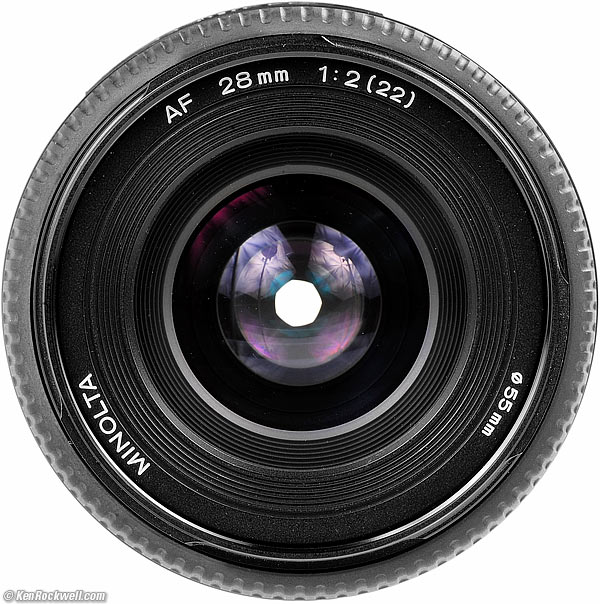
Minolta 28mm f/2 at about f/5.6.
7 blades.
Stops down to f/22.
Conventional straight blades in the 1987-1999 version.
Curved blades in the 1999-2006 version shown here.
Coverage top
35mm film, full-frame and smaller format digital.
Focal Length top
28mm.
When used on an APS-C style camera, it sees an angle of view similar to what a 45mm lens sees when used on a full-frame or 35mm camera.
Angle of View top
75.3º on 35mm MAXXUM and full-frame.
Close Focus top
1 foot (0.3 meters).
Maximum Reproduction Ratio top
1:7.7 (0.13x).
Hard Infinity Focus Stop? top
Yes.
This is great for astronomy; just turn to the stop and you have fixed laboratory-perfect focus all night.
Focus Scale top
Yes.
Depth-of-Field Scale top
Yes, but compressed.
Infra-Red Focus Index top
Not on this version.
Yes, on the older version.
Aperture Ring top
No.
Filter Thread top
55mm.
Solid alloy.
Does not rotate, but moves in and out as focused.
Size top
2.6" (67mm) diameter by 1.9" (49 mm) extension from flange.
It gets longer as focused more closely.
Weight top
9.885 oz. (280.25 g), actual measured.
Minolta specifies 10.0 oz. (285g).
Hood top
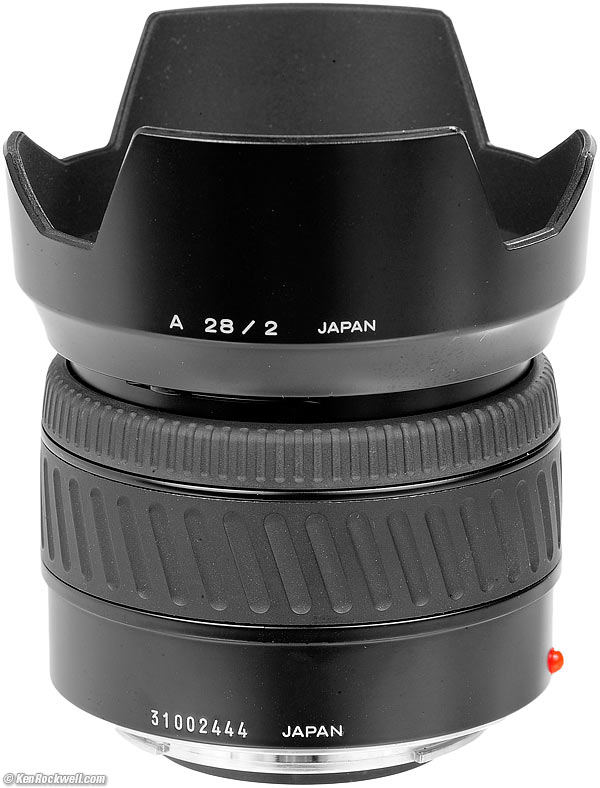
Minolta AF 28 2 with hood.
Plastic bayonet.
Same hood as for AF 35/2 and AF 35/1.4, just marked for 28/2.
Caps top
55mm snap-in front cap and standard MAXXUM rear cap.
Quality top
Made in Japan.
Price, USA top
2013 October: About $500 used if you know How to Win at eBay.
Performance top
Intro Specifications Performance Recommendations
Overall Autofocus Bokeh Coma Distortion
Ergonomics Falloff Filters Focus Breathing
Ghosts Hood Lateral Color Fringes Macro
Mechanics Sharpness Sunstars Survivability
Overall performance top
The Minolta 28mm f/2 works very well, especially on a Sony A99.
It's super-sharp, well made and has fast enough autofocus on the MAXXUM 7000 and virtually instant AF on the Sony A99.
Autofocus performance top
AF Speed
AF speed is very fast on a 2013 Sony A99, and fast on a 1985 Minolta MAXXUM 7000.
One full turn (two half-turns) of the AF screw brings it from infinity down to 2.8 feet.
AF Accuracy
On the Sony A99, focus is always dead-nuts on at f/2; I don't need any AF fine-tuning.
Manual Focus
Manual focus is perfect: smooth and precise.
A 65º turn of the focus ring brings you from infinity to 1 foot (0.3m).
Bokeh performance top
On full-frame at closest focus distance at f/2.
Bokeh, the character of out of focus areas, not simply how far out of focus they are, is fair for the background at f/2.
I wouldn't worry about it; nothing is ever much out of focus with a 28mm lens unless you are very close to your subject.
Coma performance top
Coma is common in fast wide lenses. It is when points of light turn into weird shapes in the corners, and contributes to the corners blurring at large apertures.
This lens has some coma on full-frame at f/2. It's less at f/2.8, and gone by f/4 or 5.6.
Distortion performance top
The Minolta 28mm f/2 has no visible distortion.
For more critical use, use a value of +1.0 in Photoshop's lens distortion filter at 3 meters (10 feet). It's higher-order distortion, so there is a tiny bit of waviness left.
Ergonomics (handling and ease-of-use) performance top
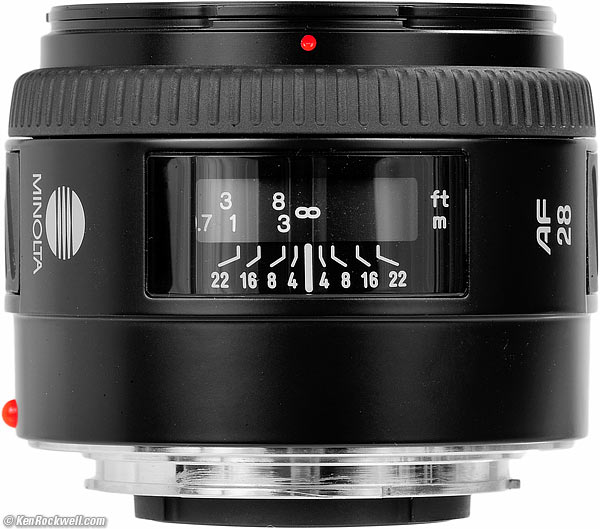
Minolta 28mm f/2.
Ergonomics are easy; the whole lens is a big rubberized metal grip for shooting, mounting and unmounting.
Swapping between auto and manual focus requires moving a switch on the camera, or maybe using the Sony A99's DMF mode, any of which can be a big pain depending on your camera.
There is a focus limiter which is flipped to engage.
Falloff (darkened corners) performance top
Falloff on full frame and 35mm is barely visible at f/2, and gone by f/2.8.
The Shading Correction in the Sony A99 probably doesn't recognize this lens; I leave it OFF.
I've exaggerated the falloff by shooting a gray field and placing these on a gray background:
Minolta AF 28mm f/2 falloff on full frame and 35mm, no correction:
© 2013 KenRockwell.com. All rights reserved.
|
Filters, use with performance top
There is no problem with vignetting on full-frame, even with a thick rotating filter or two stacked normal filters
There's no need for expensive "thin" filters.
The metal filter ring doesn't rotate, but does move forward as focused more closely.
Focus Breathing performance top
Of interest mostly to cinematographers focusing back and forth between two subjects, the image gets larger as the lens is focused more closely.
Ghosts performance top
Ghosts are a bit stronger than in newer lenses. If you have the sun shining directly into your lens and then have something dark against which the ghost will be highlighted, you may get a bright blob or two, which is an effect many shooters want:
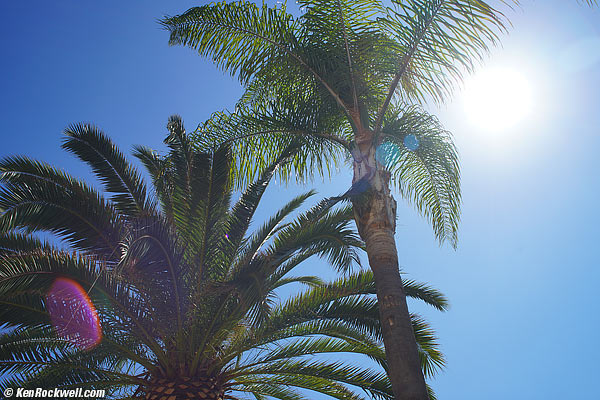
Magenta ghost: Minolta 28mm f/2 at f/8 with sun about 18mm out from center.

Green ghost: Minolta 28mm f/2 at f/8 with sun about 10mm out from center.
I'm unsure if the veiling flare seen here is from the lens, or from the fixed mirror in the optical path of the Sony A99 on which I shot this.
Hood performance top
There is a hood available, but I wouldn't use it; it doesn't do much.
The hood is the same as the hood sold for the 35mm f/2. They differ only in their painted markings!
Lateral Color Fringes performance top
On an uncorrected 24 MP Sony A99, there is a little green-magenta lateral fringing. You won't see this on 35mm film, and rarely will see it on digital when zoomed way too far in, but if you're splitting pixels, the 35mm f/2 or 35mm f/1.4 are better here, which is the biggest optical quality difference between these lenses.
Macro performance top
Macro doesn't get very close, as we expect with a wide-angle lens, and it is fairly sharp.
On full-frame at closest focus distance at f/2.
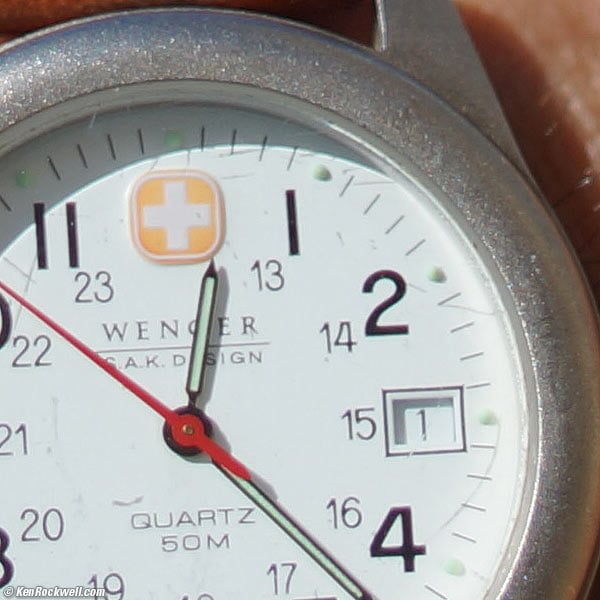
Crop from above 24MP image at f/2 at 100%. Note the nonexistent depth-of-field; the hand is out of focus! This is normal for all macro lenses.
It has lower contrast at f/2 due to spherical aberration, and is super sharp stopped down. Here's a crop from the same shot at 100% at f/8:
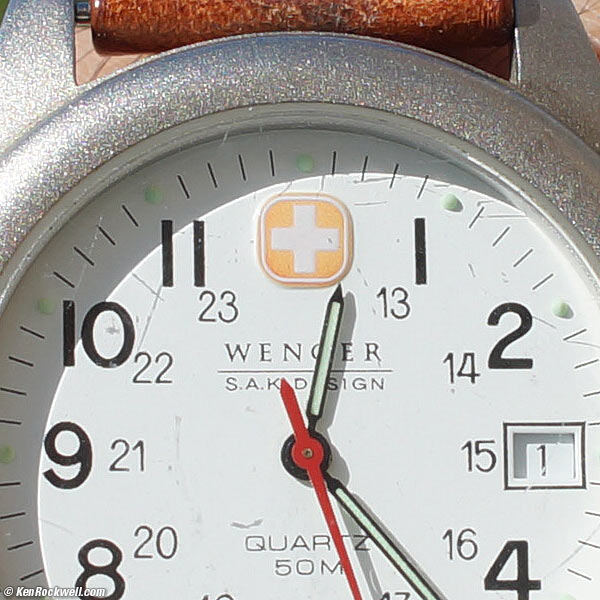
Crop from 24MP image at f/8 at 100%.
If these crops are about 6" (15cm) wide on your screen, then the entire image blown up at this same high magnification would print 60 x 40" (1.5 x 1 meter) — not bad, eh?
Mechanics and Construction performance top
Rear, Minolta 28mm f/2. enlarge.
In action to very good optics, the Minolta 28mm f/2 is almost all metal, a real lens instead of the disposable plastic garbage churned out today.
Filter Threads, Hood Mount and Forebarrel
Solid alloy.
Focus Ring
Rubber covered.
Barrel Exterior
Plastic, rubber covered around the middle.
Internals
Seems like all metal, especially the focus helicoids.
Depth-of-Field Scale
Yes, but compressed.
Aperture Ring
None.
Mount
Chromed metal.
Barrel Markings
Paint.
Mounting Index Dot
Red plastic ball.
Serial Number
Engraved into bottom of the plastic barrel and filled with white paint.
Moisture seal at mount
No.
Noises When Shaken
Clicking from the diaphragm system.
Made in
Japan.
Sharpness performance top
Image sharpness depends more on you than your lens, and lens sharpness doesn't mean much to good photographers.
The MAXXUM 28mm f/2 is very sharp, but less contrasty in the full-frame corners wide-open. So what, it's also a lot dimmer in the corners wide-open, so you probably won't notice.
As shot on the full-frame 24MP Sony A99 on the test range at infinity:
f/2
Perfectly sharp and contrasty in the center.
In full-frame corners, coma makes the farthest corners a bit lower contrast. They are darker from falloff, so you probably won't notice.
f/2.8
Perfectly sharp and contrasty in the center.
The corners are a lighter than they are at f/2, but not much contrastier than they are at f/2.
f/4
Perfectly sharp and contrasty in the center.
In full-frame corners, contrast is fine, but they are still a little softer than the rest of the image. If you're not in a lab looking under a microscope, they're perfect.
f/5.6
The center is perfect, and the corners are just about perfect, too.
f/8
Everything's perfect.
f/11
Everything's perfect.
f/16
Diffraction starts to dull the image at f/16.
f/22
Even softer from more diffraction.
This is a law of physics, not a lens limitation.
Sunstars performance top

Wimpy excuse for a sunstar at f/8.
With its curved diaphragm, the AF 28/2 makes little to no sunstars.
The earlier straight-bladed version (not shown here) probably makes nice 14-pointed sunstars on brilliant points of light.
Survivability performance top
This Minolta 28mm f/2 is already ten years old as tested.
It has no motors and no encoders. There is nothing critical to go wrong that a good repairman can't fix. The only electronics are a ROM chip that should not wear out unless you go doing something stupid, like trying to take it apart. It uses real lead solder, so it ought to last for a lifetime.
It is perfectly normal for the rubber focus ring or barrel grip to turn white from lack of use. The whiteness rubs off with use; a white looking barrel means a lens that hasn't been used much.
Therefore unlike many newer lenses today, this 28/2 AF ought to last last for plenty of more decades of great pictures.
Recommendations top
Intro Specifications Performance Recommendations
The only bad thing about this classic Minolta MAXXUM 28mm f/2 is that it still sells for almost $600 used.
If you're looking at pixels instead of at pictures as you should, the almost identical Minolta MAXXUM 35mm f/2 is very slightly sharper, mostly due to a complete lack of lateral color fringes, which are still slightly visible with this 28mm f/2.
Also consider the masterpiece Minolta MAXXUM AF 35mm f/1.4, which doesn't cost that much more, and offers a full stop more speed with the same optical excellence as the 35mm f/2, but in a bigger and heavier package.
If you've found the time, effort and expense I incur researching and sharing all this information for free, this free website's biggest source of support is when you use this link to get yours at eBay, or use or any of these links when you get anything, regardless of the country in which you live. Please always use these links when getting any of your gear so I can continue to share what I know for free — because I receive nothing for my efforts if you buy elsewhere. I'm not NPR; I don't get any government grants or have annoying fund drives to help me research and give all this information away for free.
Thanks for your support!
Ken.
Help me help you top
I support my growing family through this website, as crazy as it might seem.
The biggest help is when you use any of these links when you get anything, regardless of the country in which you live. It costs you nothing, and is this site's, and thus my family's, biggest source of support. These places have the best prices and service, which is why I've used them since before this website existed. I recommend them all personally.
If you find this page as helpful as a book you might have had to buy or a workshop you may have had to take, feel free to help me continue helping everyone.
If you've gotten your gear through one of my links or helped otherwise, you're family. It's great people like you who allow me to keep adding to this site full-time. Thanks!
If you haven't helped yet, please do, and consider helping me with a gift of $5.00.
As this page is copyrighted and formally registered, it is unlawful to make copies, especially in the form of printouts for personal use. If you wish to make a printout for personal use, you are granted one-time permission only if you PayPal me $5.00 per printout or part thereof. Thank you!
Thanks for reading!
Mr. & Mrs. Ken Rockwell, Ryan and Katie.
Home Donate New Search Gallery Reviews How-To Books Links Workshops About Contact
